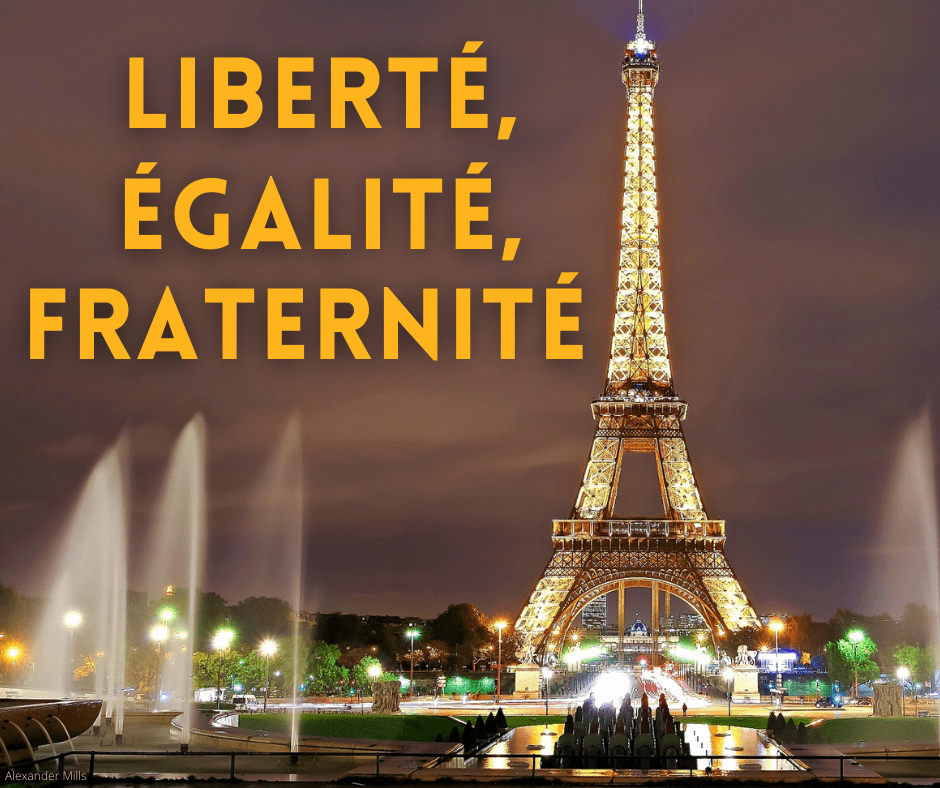
Liberté, Égalité, Fraternité
Le saviez-vous?
[English translation follows below the French]
Les notions de liberté, d'égalité et de fraternité n’ont pas été inventées par la Révolution. Le rapprochement des concepts de liberté et
d’égalité est fréquent sous les Lumières, en particulier chez Rousseau et chez Locke. Cependant il faut attendre la Révolution française
pour les voir réunies en triptyque. Dans un discours sur l'organisation des gardes nationales de décembre 1790, Robespierre propose que les
mots « Le Peuple Français » et « Liberté, Égalité, Fraternité » soient inscrits sur les uniformes et sur les drapeaux, mais son projet n'est
pas adopté.
À partir de 1793, les Parisiens, rapidement imités par les habitants des autres villes, peignent les façades de leurs maisons de cette inscription : « Unité, indivisibilité de la République ; liberté, égalité ou la mort ». La dernière partie de la formule, trop associée à la Terreur, disparaît rapidement.
Comme beaucoup de symboles révolutionnaires, la devise tombe en désuétude sous l'Empire. Elle fait son retour lors de la Révolution de 1848, qui la définit comme un principe de la République, inscrit dans la constitution. L’Église accepte alors cette triade comme un concentré de valeurs chrétienne : les prêtres célèbrent la fraternité en Christ et bénissent les arbres de la liberté.
Boudée par le Second Empire, elle finit par s'imposer sous la IIIe République, malgré quelques résistances, y compris au sein des Républicains : la solidarité est parfois préférée à l'égalité, qui implique un nivellement social, tandis que la connotation religieuse de la fraternité ne fait pas l'unanimité. La devise est inscrite sur le fronton des édifices publics le 14 juillet 1880. Elle figure dans les constitutions de 1946 et 1958 et fait aujourd'hui partie intégrante de notre patrimoine national.
ENGLISH
The notions of liberty, equality and fraternity were not invented by the Revolution. The bringing together of the concepts of freedom and
equality is frequent under the Enlightenment, in particular with Rousseau and Locke. However, it was not until the French Revolution that
they were brought together in a triptych. In a speech on the organization of the National Guards of December 1790, Robespierre proposed that
the words "Le Peuple Français" and "Liberty, Equality, Fraternity" be inscribed on the uniforms and on the flags, but his project was
not adopted.
From 1793, the Parisians, quickly imitated by the inhabitants of other cities, painted the facades of their houses with this inscription:
“Unity, indivisibility of the Republic; freedom, equality or death”. The last part of the formula, too associated with the
Terror, quickly disappears.
Like many revolutionary symbols, the motto fell into disuse under the Empire. It made its comeback during the Revolution of 1848, which defined it as a principle of the Republic, enshrined in the constitution. The Church then accepts this triad as a concentrate of Christian values: the priests celebrate brotherhood in Christ and bless the trees of liberty.
Shunned by the Second Empire, it ended up imposing itself under the Third Republic, despite some resistance, including among the Republicans: solidarity is sometimes preferred to equality, which implies a social levelling, while the religious connotation of brotherhood is not unanimous. The motto is inscribed on the pediment of public buildings on July 14, 1880. It appears in the constitutions of 1946 and 1958 and is now an integral part of our national heritage.
Design by Monsieur Graphic | Powered by Oncord
